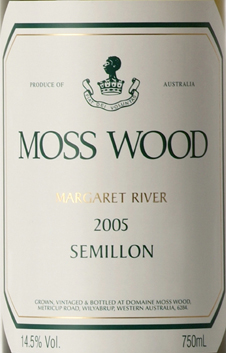Moss Wood 2005 Semillon

Wine Facts
| Harvested: | 02/3/2005 |
| Bottled: | 25/7/2005 |
| Released: | 01/11/2005 |
| Baume: | 13.10 |
| Alcohol: | 14.50% |
| Vintage Rating: | 9/10 |
SOLD OUT
Tasting Notes
Medium-straw colour, fresh, lively, even vibrant, with aromas of grapefruit citrus, lemon sherbet, figs and some bready notes, clean and crisp on the palate with ripe lemon, grapefruit and melon flavours and a refreshing, dry finish. It has a fine, tightly structured, multi-layered white with generosity of flavour and refreshing taut acidity.
Moss Wood 2024 Semillon – Erin Larkin, The Wine Advocate
The 2024 Semillon was grown in one of the hottest, driest and earliest years in Margaret River’s history, and I expected the palate to clearly reflect that. However, as testament to the detailed viticulture at Moss Wood, the wine is certainly ripe, but t displays none of the breadth or…
Vintage Notes
What a great vintage 2005 was for Moss Wood Semillon! In the lead up to harvest, temperatures were consistently warm, without any savage heat spikes and with good rainfall coming at exactly the right time so it peaked to a comfortable close. It did rain during vintage 2005 but not until two weeks after this variety was picked. Semillon in Margaret River can be prolific and, even with all the care that is taken at Moss Wood with crop estimates and bunch thinning, it can still crop far more heavily than expected. This happened in 2004 in the School Fees Block (planted in 1996) which is now a productive vineyard and an important contributor to the Semillon. We were determined that this wouldn’t be repeated in 2005 and so, although the cropping was not heavy, thanks to the consistency of the weather in the build up to vintage, the vines were crop thinned. As a result, the grapes showed better ripeness and flavour than the previous vintage. The harvest compares favourably to the best years for semillon at Moss Wood: 2001, 1999 and 1996.
Production Notes
Some slight changes were made to the winemaking process to improve the quality of juice. Instead of picking into 10 kilogram buckets which were stacked and transported to the winery for processing, the grapes are now picked into buckets which are emptied into 500 kilogram field bins and then refrigerated to 10°C. This makes for faster, more efficient and safer transfer to the winery and reduces the processing time between picking and the grapes going into the press.
Instead of destemming first and then feeding the grapes into the press, semillon is now fed into the press as whole bunches. This improves the quality of pressing because the presence of whole bunches allows the juice to run out of the press more easily and therefore makes it less likely to oxidise. The problem with sending individual berries through has been the size of the semillon grape and its slipperyness, making them hard to press. Their skins also clog the press, slowing the flow of draining juice.
Of course, the presence of stems can mean that the wine will pick up more phenolics, or tannin, and lose its fruit purity. We monitor the build up of tannins in the wine, can stop pressing and, if necessary, dump the skins and stems. They are also able to fine the juice to reduce the phenolic content. Whole bunch pressing is the traditional French approach used on whites in Burgundy and Champagne. After the juice has settled, it is fermented in stainless steel tanks at 18°C and is lees stirred once a day until after fermentation. Lees stirring then continues once a week for six weeks to improve mouthfeel and add complexity. The wine is then fined, filtered and bottled.
Cellaring Notes
The bright fruit characters of young Moss Wood Semillons can be enjoyed now but they will cellar for up to twenty years to provide the ultimate reward of luscious toast and honey that only old Semillon can deliver.

